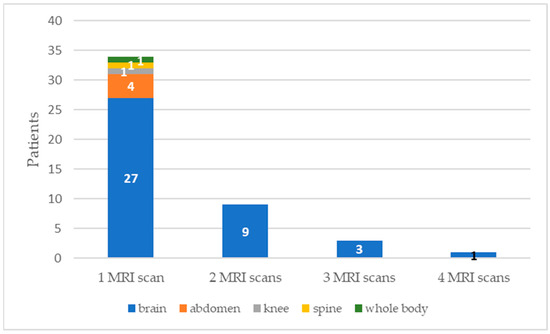Journal Description
Audiology Research
Audiology Research
is an international, scientific, peer-reviewed, open access journal on audiology and neurotology, published bimonthly online by MDPI (from Volume 10, Issue 2 - 2020). The Italian Society of Vestibology (VIS) is affiliated with Audiology Research and its members receive a discount on the article processing charges.
- Open Access— free for readers, with article processing charges (APC) paid by authors or their institutions.
- High Visibility: indexed within Scopus, ESCI (Web of Science), PubMed, PMC, Embase, and other databases.
- Rapid Publication: manuscripts are peer-reviewed and a first decision is provided to authors approximately 22.9 days after submission; acceptance to publication is undertaken in 3.7 days (median values for papers published in this journal in the second half of 2023).
- Recognition of Reviewers: APC discount vouchers, optional signed peer review, and reviewer names published annually in the journal.
Impact Factor:
1.7 (2022);
5-Year Impact Factor:
1.6 (2022)
Latest Articles
Multi-Magnet Cochlear-Implant Technology and Magnetic Resonance Imaging: The Safety Issue
Audiol. Res. 2024, 14(3), 401-411; https://doi.org/10.3390/audiolres14030034 (registering DOI) - 26 Apr 2024
Abstract
►
Show Figures
Despite the spread of novel-generation cochlear-implant (CI) magnetic systems, access to magnetic resonance imaging (MRI) for CI recipients is still limited due to safety concerns. The aim of this study is to assess and record the experiences of Hires Ultra 3D (Advanced Bionics)
[...] Read more.
Despite the spread of novel-generation cochlear-implant (CI) magnetic systems, access to magnetic resonance imaging (MRI) for CI recipients is still limited due to safety concerns. The aim of this study is to assess and record the experiences of Hires Ultra 3D (Advanced Bionics) recipients who underwent an MRI examination. A multicentric European survey about this topic was conducted focusing on safety issues, and the results were compared with the current literature. We collected a total of 65 MRI scans performed in 9 otologic referral centers for a total of 47 Hires Ultra 3D recipients, including, for the first time, 2 children and 3 teenagers. Preventive measures were represented by scanning time and sedation for children. Head wrapping was used in eight cases, and six of the eight cases received local anesthesia, even if both measures were not needed. Only three patients complained of pain (3/65 examinations, 4.6%) due to the tight head bandage, and one of the three cases required MRI scan interruption. No other adverse events were reported. We believe that these results should encourage MRI execution in accordance with manufacturer recommendations for Ultra 3D recipients.
Full article
Open AccessArticle
Bone-Anchored Hearing Aid Effects on Vestibular Function: A Preliminary Report
by
Federica Pollastri, Beatrice Giannoni, Vincenzo Marcelli, Giulia Spadavecchia and Rudi Pecci
Audiol. Res. 2024, 14(2), 386-400; https://doi.org/10.3390/audiolres14020033 - 20 Apr 2024
Abstract
Objective: Cochlear receptors are sensitive to vibratory stimuli. Based on this sensibility, bone-anchored hearing aids have been introduced to correct unilateral or bilateral conductive or mixed hearing loss and unilateral deafness. The vestibular system is also sensitive to the vibratory stimulus and this
[...] Read more.
Objective: Cochlear receptors are sensitive to vibratory stimuli. Based on this sensibility, bone-anchored hearing aids have been introduced to correct unilateral or bilateral conductive or mixed hearing loss and unilateral deafness. The vestibular system is also sensitive to the vibratory stimulus and this type of response is used in clinics to test its functionality. Being aware of this double separated sensibility, we wondered whether bone vibration, which activates the acoustic receptors of patients with bone conduction aids, can also influence the functionality of the vestibular system. Methods: To this end, we recruited 12 patients with a bone-anchored hearing aid and evaluated their vestibular function with and without an activated vibratory acoustic device. Results: Our results show that the vibratory stimulus delivered by the bone conduction aid also reaches and stimulates the vestibular receptors; this stimulation is evidenced by the appearance or modification of some nystagmus findings during bedside vestibular testing. Despite this, none of these patients complained of dizziness or vertigo during prosthesis use. Nystagmus that appeared or changed during acoustic vibratory stimulation through the prosthesis was almost all predominantly horizontal, unidirectional with respect to gaze or body position, inhibited by fixation, and most often consistent with vestibular function tests indicating peripheral vestibular damage. Conclusions: The findings of sound-evoked nystagmus seem to indicate peripheral rather than central vestibular activation. The occurrence of some predominantly horizontal and high-frequency induced nystagmus seems to attribute the response mainly to the utricle and lateral semicircular canal.
Full article
Open AccessArticle
Otic Capsule Dehiscences Simulating Other Inner Ear Diseases: Characterization, Clinical Profile, and Follow-Up—Is Ménière’s Disease the Sole Cause of Vertigo and Fluctuating Hearing Loss?
by
Joan Lorente-Piera, Carlos Prieto-Matos, Raquel Manrique-Huarte, Octavio Garaycochea, Pablo Domínguez and Manuel Manrique
Audiol. Res. 2024, 14(2), 372-385; https://doi.org/10.3390/audiolres14020032 - 12 Apr 2024
Abstract
Introduction: We present a series of six cases whose clinical presentations exhibited audiovestibular manifestations of a third mobile window mechanism, bearing a reasonable resemblance to Ménière’s disease and otosclerosis. The occurrence of these cases in such a short period has prompted a review
[...] Read more.
Introduction: We present a series of six cases whose clinical presentations exhibited audiovestibular manifestations of a third mobile window mechanism, bearing a reasonable resemblance to Ménière’s disease and otosclerosis. The occurrence of these cases in such a short period has prompted a review of the underlying causes of its development. Understanding the pathophysiology of third mobile window syndrome and considering these entities in the differential diagnosis of conditions presenting with vertigo and hearing loss with slight air-bone gaps is essential for comprehending this group of pathologies. Materials and Methods: A descriptive retrospective cohort study of six cases diagnosed at a tertiary center. All of them went through auditive and vestibular examinations before and after a therapeutic strategy was performed. Results: Out of 84 cases of dehiscences described in our center during the period from 2014 to 2024, 78 belonged to superior semicircular canal dehiscence, while 6 were other otic capsule dehiscences. Among these six patients with a mean age of 47.17 years (range: 18–73), all had some form of otic capsule dehiscence with auditory and/or vestibular repercussions, measured through hearing and vestibular tests, with abnormalities in the results in five out of six patients. Two of them were diagnosed with Ménière’s disease (MD). Another two had cochleo-vestibular hydrops without meeting the diagnostic criteria for MD. In two cases, the otic capsule dehiscence diagnosis resulted from an intraoperative complication due to a gusher phenomenon, while in one case, it was an accidental radiological finding. All responded well to the proposed treatment, whether medical or surgical, if needed. Conclusions: Otic capsule dehiscences are relatively new and unfamiliar entities that should be considered when faced with cases clinically suggestive of Ménière’s disease, with discrepancies in complementary tests or a poor response to treatment. While high-sensitivity and specificity audiovestibular tests exist, completing the study with imaging, especially petrous bone CT scans, is necessary to locate and characterize the otic capsule defect responsible for the clinical presentation.
Full article
(This article belongs to the Special Issue Third Mobile Window Syndromes: New Insights in Pathomechanisms, Instrumental Diagnosis and Surgical Treatment)
►▼
Show Figures
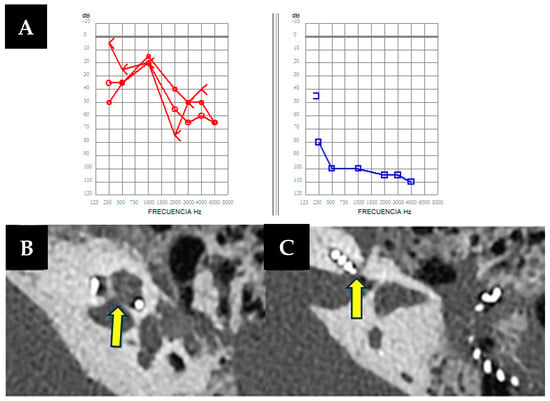
Figure 1
Open AccessArticle
AUDISTIM® Day/Night Alleviates Tinnitus-Related Handicap in Patients with Chronic Tinnitus: A Double-Blind Randomized Placebo-Controlled Trial
by
Didier Portmann, Marie José Esteve-Fraysse, Bruno Frachet, Florent Herpin, Florian Rigaudier and Christine Juhel
Audiol. Res. 2024, 14(2), 359-371; https://doi.org/10.3390/audiolres14020031 - 10 Apr 2024
Abstract
►▼
Show Figures
The aim of this study is to evaluate the efficacy of taking a daily supplement based on active compounds (AUDISTIM® Day Night: A D/N) in alleviating tinnitus-related disability, as suggested by previous real-life studies. This double-blind randomized placebo-controlled study was conducted in
[...] Read more.
The aim of this study is to evaluate the efficacy of taking a daily supplement based on active compounds (AUDISTIM® Day Night: A D/N) in alleviating tinnitus-related disability, as suggested by previous real-life studies. This double-blind randomized placebo-controlled study was conducted in adults with mild to severe tinnitus receiving a 3-month supplementation with A D/N (magnesium, vitamins, phytochemicals) or placebo (excipients without active ingredients). Tinnitus-related handicap (THI), psychological stress (MSP-9), and sleep quality (PSQI) were assessed at baseline and during intervention, perceived impression of tinnitus improvement at the end of the follow-up. The full set analysis included 114 patients (59 A D/N, 55 placebo) aged 53.8 ± 11.4 years, 58% women, with fluctuating (45%) or permanent (55%) tinnitus from 9.3 ± 9.4 years. A D/N supplementation led to greater changes in THI (−13.2 ± 16.0 vs. −6.2 ± 14.4, p = 0.0158, Cohen’s d = 0.44) at 3 months (primary outcome), especially with continuous tinnitus (−15.0 ± 16.3 vs. −4.6 ± 12.8, p = 0.0065), and, to a lesser extent, at 1 month (−9.8 ± 13.1 for A vs. −4.3 ± 12.1, p = 0.0213). PSQI significantly improved over time in both groups, but MSP-9 only with A D/N. In lines with previous observational studies, both clinical (THI score > 7 pts) and statistical (vs. placebo) improvement, more pronounced in permanent tinnitus, demonstrate the effectiveness of the combination of active compounds and support its use in the management of mild to severe tinnitus.
Full article
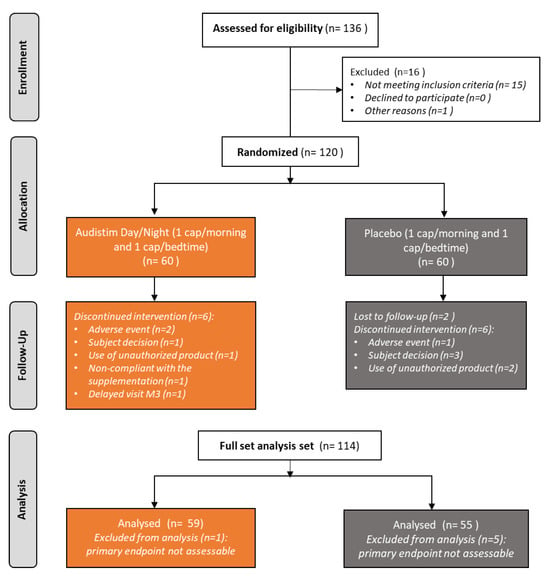
Figure 1
Open AccessArticle
Digits-in-Noise Test as an Assessment Tool for Hearing Loss and Hearing Aids
by
Carly Schimmel, Kayla Cormier, Vinaya Manchaiah, De Wet Swanepoel and Anu Sharma
Audiol. Res. 2024, 14(2), 342-358; https://doi.org/10.3390/audiolres14020030 - 08 Apr 2024
Abstract
►▼
Show Figures
The aim of this study was to examine the relationship between an American English Digits in Noise (DIN) test and commonly used audiological measures to evaluate the DIN test’s ability to detect hearing loss and validate hearing aid fitting. QuickSIN and DIN tests
[...] Read more.
The aim of this study was to examine the relationship between an American English Digits in Noise (DIN) test and commonly used audiological measures to evaluate the DIN test’s ability to detect hearing loss and validate hearing aid fitting. QuickSIN and DIN tests were completed by participants with untreated hearing loss (n = 46), prescription hearing aids (n = 15), and over-the-counter (OTC) hearing aids (n = 12). Performance on the QuickSIN showed moderate positive correlations with DIN for untreated hearing loss participants and prescription hearing aid users, but not for OTC hearing aid users. For untreated hearing loss participants, both QuickSIN and DIN tests showed positive moderate to strong correlations with high frequency puretone averages. In OTC users, DIN scores did not significantly change over a 6-month time period and were better when conducted remotely compared to in-person testing. Our results suggest that the DIN test may be a feasible monitoring option for individuals with hearing loss and those fitted with hearing aids. However, due to small sample size in this pilot study, future research is needed to examine DIN test’s utility for fitting and validating OTC hearing aids.
Full article
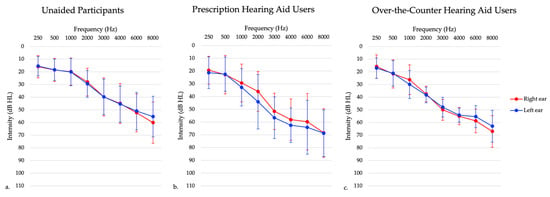
Figure 1
Open AccessArticle
Assessing the Effectiveness of Different Hyperbaric Oxygen Treatment Methods in Patients with Sudden Sensorineural Hearing Loss
by
Paweł Rozbicki, Jacek Usowski, Sandra Krzywdzińska, Dariusz Jurkiewicz and Jacek Siewiera
Audiol. Res. 2024, 14(2), 333-341; https://doi.org/10.3390/audiolres14020029 - 29 Mar 2024
Abstract
Introduction: Hyperbaric oxygen therapy (HBOT) is one of the treatment methods in patients with sudden sensorineural hearing loss (SSNHL). It is recommended as an elective treatment in patients undergoing steroid therapy. According to current scientific reports, HBOT should be implemented within two weeks
[...] Read more.
Introduction: Hyperbaric oxygen therapy (HBOT) is one of the treatment methods in patients with sudden sensorineural hearing loss (SSNHL). It is recommended as an elective treatment in patients undergoing steroid therapy. According to current scientific reports, HBOT should be implemented within two weeks after the first symptoms. However, as far as the profile of HBOT is concerned, there are no straightforward recommendations. Methods: The data obtained from the medical records of 218 patients undergoing HBOT for SSNHL at the Military Institute of Medicine—National Research Institute were analyzed statistically for the impact of the duration and the delay in implementing HBOT on the end results of pure-tone audiometry (PTA). Results: A statistically significant hearing improvement in patients undergoing more than 15 cycles of HBOT was detected at all frequencies except for 1500 Hz; in the group reporting for treatment with a delay of more than 10 days, hearing improvement was statistically unsignificant at frequencies of 1500, 3000, and 4000 Hz. Conclusions: The statistical analysis showed that the urgent onset of HBOT could be a significant factor in the therapy of SSNHL.
Full article
(This article belongs to the Special Issue Hearing Loss: Causes, Symptoms, Diagnosis, and Treatment)
Open AccessArticle
Posterior Semicircular Canal Dehiscence with Vestibulo-Ocular Reflex Reduction for the Affected Canal at the Video-Head Impulse Test: Considerations to Pathomechanisms
by
Andrea Castellucci, Georges Dumas, Sawsan M. Abuzaid, Enrico Armato, Salvatore Martellucci, Pasquale Malara, Mohamad Alfarghal, Rosanna Rita Ruberto, Pasquale Brizzi, Angelo Ghidini, Francesco Comacchio and Sébastien Schmerber
Audiol. Res. 2024, 14(2), 317-332; https://doi.org/10.3390/audiolres14020028 - 24 Mar 2024
Abstract
►▼
Show Figures
Posterior semicircular canal dehiscence (PSCD) has been demonstrated to result in a third mobile window mechanism (TMWM) in the inner ear similar to superior semicircular canal dehiscence (SSCD). Typical clinical and instrumental features of TMWM, including low-frequency conductive hearing loss (CHL), autophony, pulsatile
[...] Read more.
Posterior semicircular canal dehiscence (PSCD) has been demonstrated to result in a third mobile window mechanism (TMWM) in the inner ear similar to superior semicircular canal dehiscence (SSCD). Typical clinical and instrumental features of TMWM, including low-frequency conductive hearing loss (CHL), autophony, pulsatile tinnitus, sound/pressure-induced vertigo and enhanced vestibular-evoked myogenic potentials, have been widely described in cases with PSCD. Nevertheless, video-head impulse test (vHIT) results have been poorly investigated. Here, we present six patients with PSCD presenting with a clinical scenario consistent with a TMWM and an impaired vestibulo-ocular reflex (VOR) for the affected canal on vHIT. In two cases, an additional dehiscence between the facial nerve and the horizontal semicircular canal (HSC) was detected, leading to a concurrent VOR impairment for the HSC. While in SSCD, a VOR gain reduction could be ascribed to a spontaneous “auto-plugging” process due to a dural prolapse into the canal, the same pathomechanism is difficult to conceive in PSCD due to a different anatomical position, making a dural herniation less likely. Alternative putative pathomechanisms are discussed, including an endolymphatic flow dissipation during head impulses as already hypothesized in SSCD. The association of symptoms/signs consistent with TMWM and a reduced VOR gain for the posterior canal might address the diagnosis toward PSCD.
Full article
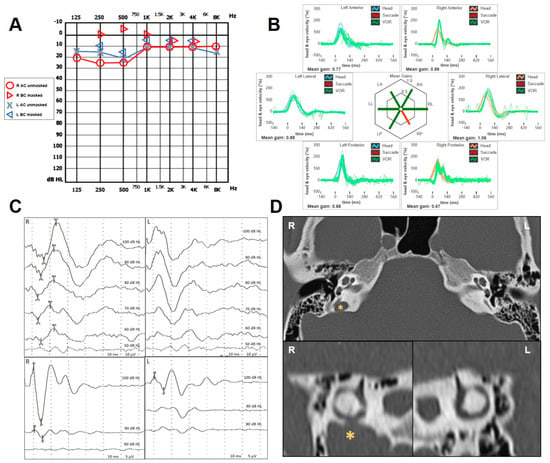
Figure 1
Open AccessArticle
Large Vestibular Aqueduct-Associated Symptoms: Endolymphatic Duct Blockage as a Surgical Treatment
by
Issam Saliba, Sarah Alshehri, Isabelle Fournier and Nasser Altamami
Audiol. Res. 2024, 14(2), 304-316; https://doi.org/10.3390/audiolres14020027 - 18 Mar 2024
Abstract
►▼
Show Figures
Objective: This study aimed to evaluate the effectiveness of endolymphatic duct blockage (EDB) on dizziness control in patients with a large vestibular aqueduct (LVA) and to evaluate its effect on hearing. Study design: This is a prospective nonrandomized study. Setting: Five adults and
[...] Read more.
Objective: This study aimed to evaluate the effectiveness of endolymphatic duct blockage (EDB) on dizziness control in patients with a large vestibular aqueduct (LVA) and to evaluate its effect on hearing. Study design: This is a prospective nonrandomized study. Setting: Five adults and one child with dizziness and five children with progressive hearing loss were referred to our tertiary centers. Methods: The dizziness handicap inventory (DHI) and DHI-PC (dizziness handicap inventory—patient caregiver) questionnaires were used before and after surgery. All patients underwent a preoperative temporal bone HRCT scan and pure tone audiometry one day before surgery, then four and twelve months after surgery and at the last follow-up. The mean follow-up time was 5.6 years. Student’s t-test was used to compare DHI/-PC results. Results: The DHI scores were 44, 24, 84, 59 and 56 before surgery, respectively, for Patients 1 to 5. The DHI scores at four months was significantly different, i.e., 4, 6, 0, 7 and 18 (p = 0.001). No differences were found between 4 and 12 months. Patient 6 (child) had Trisomy 21; their DHI-PC score dropped from 38 (preoperative score) to 8 (postoperative score), showing no activity limitations; clinical evaluation showed the complete resolution of symptoms. We found no significant differences between hearing loss before the surgery and at 1 and 12 months post operation for four adult patients. Our fifth adult patient’s hearing changed from severe to profound SNHL. For 5 out of 6 pediatric patients, preoperative PTA and mean ABG were 63 dB and 20 dB, respectively; postoperatively, they improved to 42 dB and 16 dB, respectively. The hearing loss level for the sixth pediatric patient dropped from moderate (PTA = 42 dB) to severe (PTA = 85 dB) due to an opening of the endolymphatic sac and a sudden leak of the endolymph. Conclusions: EDB, using two titanium clips, seems to be helpful for controlling vestibular symptoms and for stabilizing hearing or even to improve hearing in 82% of cases. Nevertheless, there is a risk of hearing worsening.
Full article

Figure 1
Open AccessArticle
Over-the-Counter (OTC) Hearing Aid Availability across the Spectrum of Human Skin Colors
by
Shade Avery Kirjava and Sam Jones Faulkner
Audiol. Res. 2024, 14(2), 293-303; https://doi.org/10.3390/audiolres14020026 - 12 Mar 2024
Abstract
Background: Over-the-counter (OTC) hearing aids were recently approved for sale in the United States. Research has shown that consumers prefer hearing devices that match their skin color because these devices are less noticeable. Colorism is discrimination against individuals with relatively darker skin that
[...] Read more.
Background: Over-the-counter (OTC) hearing aids were recently approved for sale in the United States. Research has shown that consumers prefer hearing devices that match their skin color because these devices are less noticeable. Colorism is discrimination against individuals with relatively darker skin that manifests in “skin-color” product offerings as products being offered primarily in relatively lighter colors. Methods: This study compared images of U.S. Food and Drug Administration (FDA)-registered over-the-counter hearing aids to a range of human skin colors. Results: Most over-the-counter hearing aids are only offered in relatively lighter beige colors. Few over-the-counter hearing aids are available in darker skin colors. Conclusions: These findings may represent structural bias, preventing equitable access to darker skin-color OTC hearing aids for individuals with darker skin.
Full article
(This article belongs to the Special Issue Hearing Loss: Causes, Symptoms, Diagnosis, and Treatment)
►▼
Show Figures
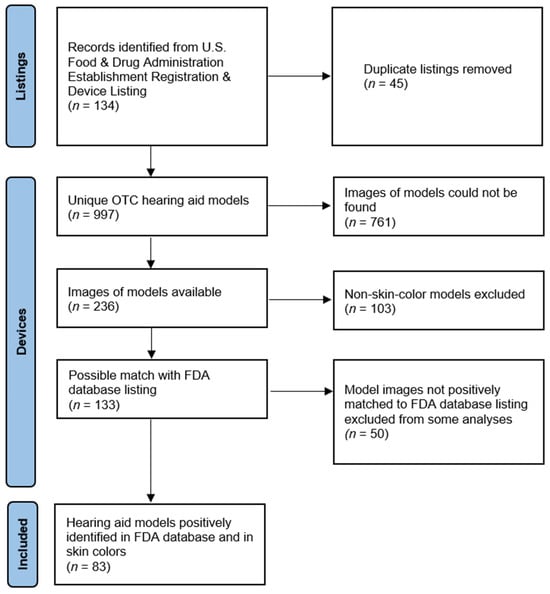
Figure 1
Open AccessArticle
Renewed Concept of Mastoid Cavity Obliteration with the Use of Temporoparietal Fascial Flap Injected by Injectable Platelet-Rich Fibrin after Subtotal Petrosectomy for Cochlear Implant Patients
by
Aleksander Zwierz, Krystyna Masna, Paweł Burduk, Stephan Hackenberg and Matthias Scheich
Audiol. Res. 2024, 14(2), 280-292; https://doi.org/10.3390/audiolres14020025 - 01 Mar 2024
Abstract
Background: The subtotal petrosectomy procedure may be useful for cochlear implantation in selected patient groups. Although it is highly effective, complications can arise, which may have economic implications for the patient due to the high cost of the device. Therefore, several authors have
[...] Read more.
Background: The subtotal petrosectomy procedure may be useful for cochlear implantation in selected patient groups. Although it is highly effective, complications can arise, which may have economic implications for the patient due to the high cost of the device. Therefore, several authors have attempted to identify the most effective concept for obliteration. Methods: We present a pilot descriptive study of application techniques for obliterating cavities after subtotal petrosectomy using a temporoparietal fascial flap (TPFF) modified with injectable platelet-rich fibrin (IPRF+) for three cochlear implant (CI) patients. Results: Our concept preserves important anatomical structures, such as the temporalis muscle, which covers the CI receiver–stimulator. Injection of IPRF+ also increases the available tissue volume for obliteration and enhances its anti-inflammatory and regenerative potential. Conclusions: To the best of our knowledge, the use of TPFF for filling the cavity has not been adopted for CI with SP and for blind sac closure. Our literature review and our experience with this small group of patients suggest that this procedure, when combined with IPRF+ injections, may reduce the risk of potential infection in the obliterated cavity, particularly when used with CI. This technique is applicable only in cases when the surgeons are convinced that the middle ear cavity is purged of cholesteatoma.
Full article
(This article belongs to the Special Issue Hearing Loss: Causes, Symptoms, Diagnosis, and Treatment)
►▼
Show Figures
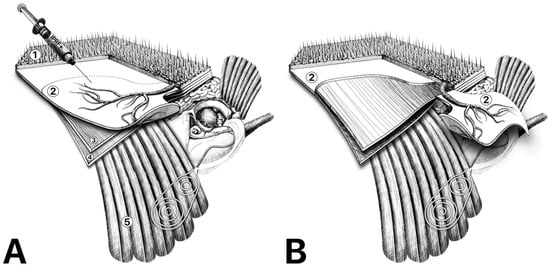
Figure 1
Open AccessArticle
Development of New Open-Set Speech Material for Use in Clinical Audiology with Speakers of British English
by
Mahmoud Keshavarzi, Marina Salorio-Corbetto, Tobias Reichenbach, Josephine Marriage and Brian C. J. Moore
Audiol. Res. 2024, 14(2), 264-279; https://doi.org/10.3390/audiolres14020024 - 26 Feb 2024
Abstract
Background: The Chear open-set performance test (COPT), which uses a carrier phrase followed by a monosyllabic test word, is intended for clinical assessment of speech recognition, evaluation of hearing-device performance, and the fine-tuning of hearing devices for speakers of British English. This paper
[...] Read more.
Background: The Chear open-set performance test (COPT), which uses a carrier phrase followed by a monosyllabic test word, is intended for clinical assessment of speech recognition, evaluation of hearing-device performance, and the fine-tuning of hearing devices for speakers of British English. This paper assesses practice effects, test–retest reliability, and the variability across lists of the COPT. Method: In experiment 1, 16 normal-hearing participants were tested using an initial version of the COPT, at three speech-to-noise ratios (SNRs). Experiment 2 used revised COPT lists, with items swapped between lists to reduce differences in difficulty across lists. In experiment 3, test–retest repeatability was assessed for stimuli presented in quiet, using 15 participants with sensorineural hearing loss. Results: After administration of a single practice list, no practice effects were evident. The critical difference between scores for two lists was about 2 words (out of 15) or 5 phonemes (out of 50). The mean estimated SNR required for 74% words correct was −0.56 dB, with a standard deviation across lists of 0.16 dB. For the participants with hearing loss tested in quiet, the critical difference between scores for two lists was about 3 words (out of 15) or 6 phonemes (out of 50).
Full article
(This article belongs to the Special Issue Rehabilitation of Hearing Impairment: 2nd Edition)
►▼
Show Figures
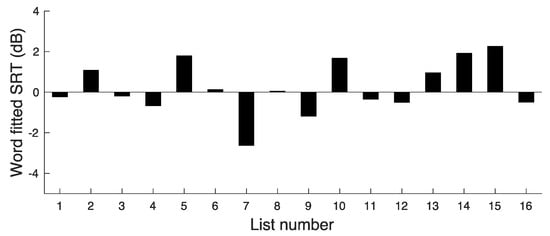
Figure 1
Open AccessReview
Navigating the Usher Syndrome Genetic Landscape: An Evaluation of the Associations between Specific Genes and Quality Categories of Cochlear Implant Outcomes
by
Micol Busi and Alessandro Castiglione
Audiol. Res. 2024, 14(2), 254-263; https://doi.org/10.3390/audiolres14020023 - 26 Feb 2024
Abstract
Usher syndrome (US) is a clinically and genetically heterogeneous disorder that involves three main features: sensorineural hearing loss, retinitis pigmentosa (RP), and vestibular impairment. With a prevalence of 4–17/100,000, it is the most common cause of deaf-blindness worldwide. Genetic research has provided crucial
[...] Read more.
Usher syndrome (US) is a clinically and genetically heterogeneous disorder that involves three main features: sensorineural hearing loss, retinitis pigmentosa (RP), and vestibular impairment. With a prevalence of 4–17/100,000, it is the most common cause of deaf-blindness worldwide. Genetic research has provided crucial insights into the complexity of US. Among nine confirmed causative genes, MYO7A and USH2A are major players in US types 1 and 2, respectively, whereas CRLN1 is the sole confirmed gene associated with type 3. Variants in these genes also contribute to isolated forms of hearing loss and RP, indicating intersecting molecular pathways. While hearing loss can be adequately managed with hearing aids or cochlear implants (CIs), approved RP treatment modalities are lacking. Gene replacement and editing, antisense oligonucleotides, and small-molecule drugs hold promise for halting RP progression and restoring vision, enhancing patients’ quality of life. Massively parallel sequencing has identified gene variants (e.g., in PCDH15) that influence CI results. Accordingly, preoperative genetic examination appears valuable for predicting CI success. To explore genetic mutations in CI recipients and establish correlations between implant outcomes and involved genes, we comprehensively reviewed the literature to gather data covering a broad spectrum of CI outcomes across all known US-causative genes. Implant outcomes were categorized as excellent or very good, good, poor or fair, and very poor. Our review of 95 cochlear-implant patients with US, along with their CI outcomes, revealed the importance of presurgical genetic testing to elucidate potential challenges and provide tailored counseling to improve auditory outcomes. The multifaceted nature of US demands a comprehensive understanding and innovative interventions. Genetic insights drive therapeutic advancements, offering potential remedies for the retinal component of US. The synergy between genetics and therapeutics holds promise for individuals with US and may enhance their sensory experiences through customized interventions.
Full article
(This article belongs to the Special Issue Genetics of Hearing Loss—Volume II)
Open AccessReview
Autosomal Recessive Non-Syndromic Deafness: Is AAV Gene Therapy a Real Chance?
by
Davide Brotto, Marco Greggio, Cosimo De Filippis and Patrizia Trevisi
Audiol. Res. 2024, 14(2), 239-253; https://doi.org/10.3390/audiolres14020022 - 22 Feb 2024
Abstract
The etiology of sensorineural hearing loss is heavily influenced by genetic mutations, with approximately 80% of cases attributed to genetic causes and only 20% to environmental factors. Over 100 non-syndromic deafness genes have been identified in humans thus far. In non-syndromic sensorineural hearing
[...] Read more.
The etiology of sensorineural hearing loss is heavily influenced by genetic mutations, with approximately 80% of cases attributed to genetic causes and only 20% to environmental factors. Over 100 non-syndromic deafness genes have been identified in humans thus far. In non-syndromic sensorineural hearing impairment, around 75–85% of cases follow an autosomal recessive inheritance pattern. In recent years, groundbreaking advancements in molecular gene therapy for inner-ear disorders have shown promising results. Experimental studies have demonstrated improvements in hearing following a single local injection of adeno-associated virus-derived vectors carrying an additional normal gene or using ribozymes to modify the genome. These pioneering approaches have opened new possibilities for potential therapeutic interventions. Following the PRISMA criteria, we summarized the AAV gene therapy experiments showing hearing improvement in the preclinical phases of development in different animal models of DFNB deafness and the AAV gene therapy programs currently in clinical phases targeting autosomal recessive non syndromic hearing loss. A total of 17 preclinical studies and 3 clinical studies were found and listed. Despite the hurdles, there have been significant breakthroughs in the path of HL gene therapy, holding great potential for providing patients with novel and effective treatment.
Full article
(This article belongs to the Special Issue Genetics of Hearing Loss—Volume II)
►▼
Show Figures
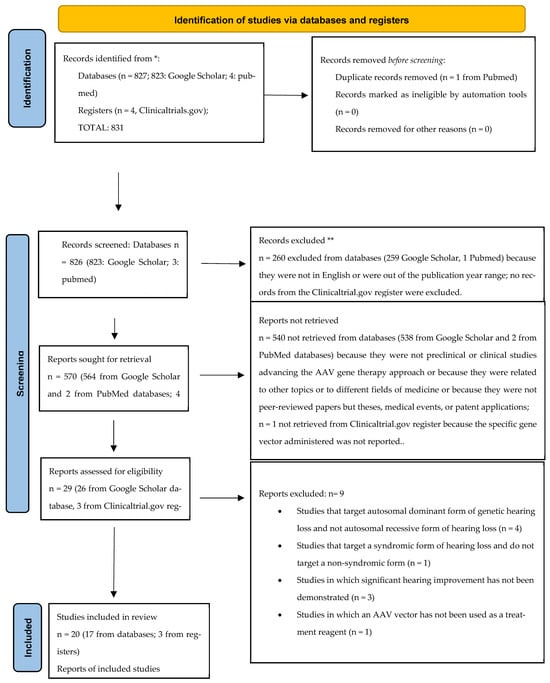
Figure 1
Open AccessArticle
Intraoperative Measurement of Insertion Speed in Cochlear Implant Surgery: A Preliminary Experience with Cochlear SmartNav
by
Stefano Concheri, Davide Brotto, Marzia Ariano, Antonio Daloiso, Valerio Maria Di Pasquale Fiasca, Flavia Sorrentino, Beatrice Coppadoro, Patrizia Trevisi, Elisabetta Zanoletti and Sebastiano Franchella
Audiol. Res. 2024, 14(2), 227-238; https://doi.org/10.3390/audiolres14020021 - 22 Feb 2024
Abstract
Objectives: The objectives were to present the real-time estimated values of cochlear implant (CI) electrode insertion speed (IS) during intraoperative sessions using the Cochlear Nucleus SmartNav System to assess whether this measure affected CI outcomes and to determine whether real-time feedback assists expert
[...] Read more.
Objectives: The objectives were to present the real-time estimated values of cochlear implant (CI) electrode insertion speed (IS) during intraoperative sessions using the Cochlear Nucleus SmartNav System to assess whether this measure affected CI outcomes and to determine whether real-time feedback assists expert surgeons in achieving slow insertion. Methods: The IS was measured in 52 consecutive patients (65 implanted ears) using the CI632 electrode. The IS values were analyzed in relation to procedure repetition over time, NRT ratio, and CI audiological outcomes. Results: The average IS was 0.64 mm/s (SD = 0.24); minimum and maximum values were 0.23 and 1.24 mm/s, respectively. The IS significantly decreased with each array insertion by the operator (p = 0.006), and the mean decreased by 24% between the first and last third of procedures; however, this reduction fell within the error range of SmartNav for IS (+/−0.48 mm/s). No correlation was found between IS and the NRT ratio (p = 0.51), pure-tone audiometry (PTA) at CI activation (p = 0.506), and PTA (p = 0.94) or word recognition score (p = 0.231) at last evaluation. Conclusions: The estimated IS reported by SmartNav did not result in a clinically significant reduction in insertion speed or an improvement in CI hearing outcomes. Real-time feedback of IS could potentially be used for training, but its effectiveness requires confirmation through additional studies and more accurate tools. Implementation of IS assessment in clinical practice will enable comparisons between measurement techniques and between manual and robot-assisted insertions. This will help define the optimal IS range to achieve better cochlear implant (CI) outcomes.
Full article
(This article belongs to the Collection Cochlear Implants: Challenges and Opportunities in Hearing Rehabilitation)
►▼
Show Figures
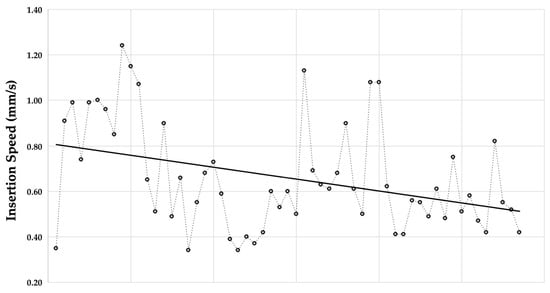
Figure 1
Open AccessCase Report
Effects of Musical Training in Music Therapy Following Cochlear Implantation—A Case Report
by
Astrid Magele, Bianca Wirthner, Philipp Schoerg and Georg M. Sprinzl
Audiol. Res. 2024, 14(2), 217-226; https://doi.org/10.3390/audiolres14020020 - 22 Feb 2024
Abstract
The most prevalent sensory impairment impacting the elderly is age-related hearing loss (HL), which affects around 65% of individuals over the age of 60 years. This bilateral, symmetrical sensorineural impairment profoundly affects auditory perception, speech discrimination, and the overall understanding of auditory signals.
[...] Read more.
The most prevalent sensory impairment impacting the elderly is age-related hearing loss (HL), which affects around 65% of individuals over the age of 60 years. This bilateral, symmetrical sensorineural impairment profoundly affects auditory perception, speech discrimination, and the overall understanding of auditory signals. Influenced by diverse factors, age-related HL can substantially influence an individual’s quality of life and mental health and can lead to depression. Cochlear implantation (CI) stands as a standard intervention, yet despite advancements, music perception challenges persist, which can be addressed with individualized music therapy. This case report describes the journey of an 81-year-old musician through profound sensorineural hearing loss, cochlear implantation, and rehabilitative music therapy. Auditory evaluations, musical exercises, and quality of life assessments highlighted meaningful improvements in music perception, auditory skills, and overall satisfaction post-implantation. Music therapy facilitated emotional, functional, and musical levels of engagement, notably enhancing his ability to perceive melody, rhythm, and different instruments. Moreover, subjective assessments and audiograms indicated marked improvements in auditory differentiation, music enjoyment, and overall hearing thresholds. This comprehensive approach integrating bilateral CIs and music therapy showcased audiological and quality of life enhancements in an elderly individual with profound hearing loss, emphasizing the efficacy of this combined treatment approach.
Full article
(This article belongs to the Special Issue Music Perception in Cochlear Implant Recipients)
►▼
Show Figures
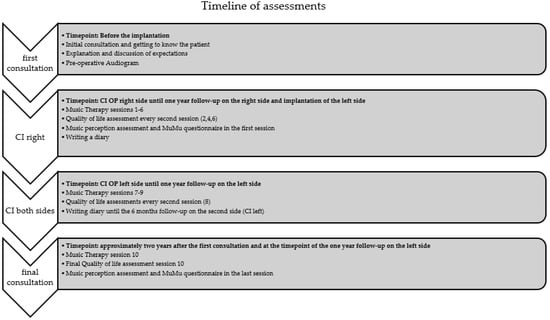
Figure 1
Open AccessArticle
Association of Head Injury, Neck Injury or Acoustic Trauma on Phenotype of Ménière’s Disease
by
Ilmari Pyykkö, Vinay, Artur Vetkas, Jing Zou and Vinaya Manchaiah
Audiol. Res. 2024, 14(1), 204-216; https://doi.org/10.3390/audiolres14010019 - 17 Feb 2024
Abstract
►▼
Show Figures
The aim of the present study was to investigate adverse effects of head injury, neck trauma, and chronic noise exposure on the complaint profile in people with Ménière’s disease (MD). The study used a retrospective design. Register data of 912 patients with MD
[...] Read more.
The aim of the present study was to investigate adverse effects of head injury, neck trauma, and chronic noise exposure on the complaint profile in people with Ménière’s disease (MD). The study used a retrospective design. Register data of 912 patients with MD from the Finnish Ménière Federation database were studied. The data comprised case histories of traumatic brain injury (TBI), neck trauma and occupational noise exposure, MD specific complaints, impact related questions, and the E-Qol health-related quality of life instrument. TBI was classified based on mild, moderate, and severe categories of transient loss of consciousness (TLoC). The mean age of the participants was 60.2 years, the mean duration of the disease was 12.6 years, and 78.7% were females. Logistic regression analysis, linear correlation, and pairwise comparisons were used in evaluating the associations. 19.2% of the participants with MD had a history of TBI. The phenotype of participants with TBI was associated with frequent vestibular drop attacks (VDA), presyncope, headache-associated vertigo, and a reduction in the E-QoL. Logistic regression analysis explained the variability of mild TBI in 6.8%. A history of neck trauma was present in 10.8% of the participants. Neck trauma associated with vertigo (NTwV) was seen in 47 and not associated with vertigo in 52 participants. The phenotype of NTwV was associated with balance problems, VDA, physical strain-induced vertigo, and hyperacusia. Logistic regression analysis explained 8.7% of the variability of the complaint profile. Occupational noise exposure was recorded in 25.4% of the participants and correlated with the greater impact of tinnitus, hyperacusis, and hearing loss. Neither the frequency, duration, or severity of vertigo or nausea were significantly different between the baseline group and the TBI, NTwV, or noise-exposure groups. The results indicate that TBI and NTwV are common among MD patients and may cause a confounder effect.
Full article
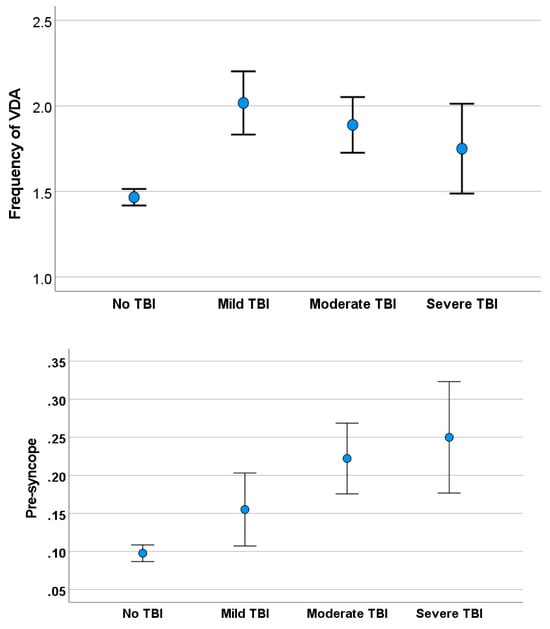
Figure 1
Open AccessArticle
Soft Tissue Conduction Activates the Auditory Pathway in the Brain
by
Miriam Geal-Dor and Haim Sohmer
Audiol. Res. 2024, 14(1), 196-203; https://doi.org/10.3390/audiolres14010018 - 16 Feb 2024
Abstract
►▼
Show Figures
Soft tissue conduction is a mode of hearing which differs from air and bone conduction since the soft tissues of the body convey the audio-frequency vibrations to the ear. It is elicited by inducing soft tissue vibrations with an external vibrator applied to
[...] Read more.
Soft tissue conduction is a mode of hearing which differs from air and bone conduction since the soft tissues of the body convey the audio-frequency vibrations to the ear. It is elicited by inducing soft tissue vibrations with an external vibrator applied to sites on the body or by intrinsic vibrations resulting from vocalization or the heartbeat. However, the same external vibrator applied to the skin sites also excites cutaneous mechanoreceptors, and attempts have been made to assist patients with hearing loss by audio–tactile substitution. The present study was conducted to assess the contribution of the auditory nerve and brainstem pathways to soft tissue conduction hearing. The study involved 20 normal hearing students, equipped with ear plugs to reduce the possibility of their response to air-conducted sounds produced by the external vibrator. Pure tone audiograms and speech reception (recognition) thresholds were determined in response to the delivery of the stimuli by a clinical bone vibrator applied to the cheek, neck and shoulder. Pure tone and speech recognition thresholds were obtained; the participants were able to repeat the words they heard by soft tissue conduction, confirming that the auditory pathways in the brain had been stimulated, with minimal involvement of the somatosensory pathways.
Full article
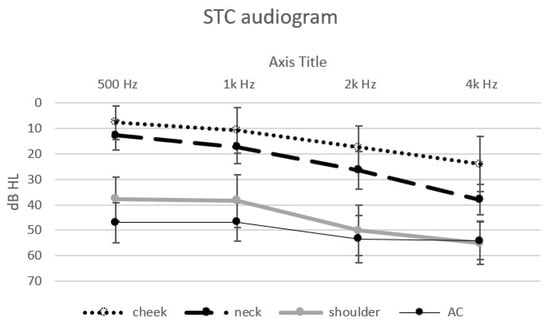
Figure 1
Open AccessArticle
Auditory Profile-Based Hearing Aid Fitting: Self-Reported Benefit for First-Time Hearing Aid Users
by
Oscar M. Cañete, Gérard Loquet, Raul Sánchez-López, Dan Dupont Hougaard, Rikke Schnack-Petersen, Michael Gaihede, Jesper H. Schmidt, Dorte Hammershøi and Tobias Neher
Audiol. Res. 2024, 14(1), 183-195; https://doi.org/10.3390/audiolres14010017 - 08 Feb 2024
Abstract
►▼
Show Figures
Background: Although hearing aids (HAs) can compensate for reduced audibility, functional outcomes and benefits vary widely across individuals. As part of the Danish ‘Better hEAring Rehabilitation’ (BEAR) project, four distinct auditory profiles differing in terms of audiometric thresholds and supra-threshold hearing abilities were
[...] Read more.
Background: Although hearing aids (HAs) can compensate for reduced audibility, functional outcomes and benefits vary widely across individuals. As part of the Danish ‘Better hEAring Rehabilitation’ (BEAR) project, four distinct auditory profiles differing in terms of audiometric thresholds and supra-threshold hearing abilities were recently identified. Additionally, profile-specific HA-fitting strategies were proposed. The aim of the current study was to evaluate the self-reported benefit of these profile-based HA fittings in a group of new HA users. Methods: A total of 205 hearing-impaired older adults were recruited from two Danish university hospitals. Participants were randomly allocated to one of two treatment groups: (1) NAL-NL2 gain prescription combined with default advanced feature settings (‘reference fitting’) or (2) auditory profile-based fitting with tailored gain prescription and advanced feature settings (‘BEAR fitting’). Two months after treatment, the participants completed the benefit version of the short form of the Speech, Spatial, and Qualities of Hearing Scale (SSQ12-B) and the International Outcome Inventory for Hearing Aids (IOI-HA) questionnaire. Results: Overall, participants reported a clear benefit from HA treatment. However, no significant differences in the SSQ12-B or IOI-HA scores between the reference and BEAR fittings were found. Conclusion: First-time users experience clear benefits from HA treatment. Auditory profile-based HA fitting warrants further investigation.
Full article
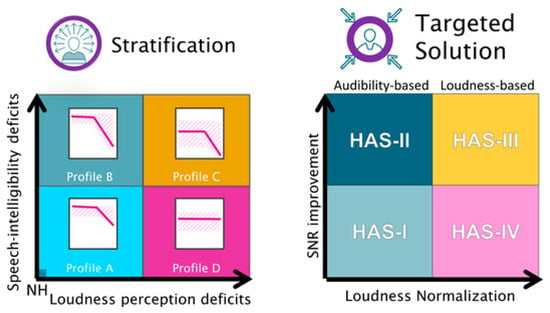
Figure 1
Open AccessReply
Reply to Theodorou et al. Comment on “Umemoto et al. Management of Migraine-Associated Vestibulocochlear Disorders. Audiol. Res. 2023, 13, 528–545”
by
Najva Mazhari, Karen Tawk, Kayla K. Umemoto, Mehdi Abouzari and Hamid R. Djalilian
Audiol. Res. 2024, 14(1), 181-182; https://doi.org/10.3390/audiolres14010016 - 07 Feb 2024
Abstract
We thank the authors for their insightful and thoughtful commentary on our recent publication [...]
Full article
(This article belongs to the Special Issue Auditory Disorders: Incidence, Intervention and Treatment)
Open AccessComment
Comment on Umemoto et al. Management of Migraine-Associated Vestibulocochlear Disorders. Audiol. Res. 2023, 13, 528–545
by
Daphne J. Theodorou, Stavroula J. Theodorou and Vasilios Mitsios
Audiol. Res. 2024, 14(1), 179-180; https://doi.org/10.3390/audiolres14010015 - 07 Feb 2024
Cited by 1
Abstract
We read with great interest the recent article by Umemoto, K. [...]
Full article
(This article belongs to the Special Issue Auditory Disorders: Incidence, Intervention and Treatment)
►▼
Show Figures
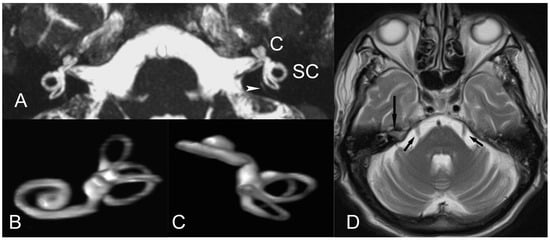
Figure 1

Journal Menu
► ▼ Journal Menu-
- Audiology Research Home
- Aims & Scope
- Editorial Board
- Topical Advisory Panel
- Instructions for Authors
- Special Issues
- Topics
- Topical Collections
- Article Processing Charge
- Indexing & Archiving
- Editor’s Choice Articles
- Most Cited & Viewed
- Journal Statistics
- Journal History
- Journal Awards
- Society Collaborations
- Editorial Office
Journal Browser
► ▼ Journal BrowserHighly Accessed Articles
Latest Books
E-Mail Alert
News
Topics

Conferences
Special Issues
Special Issue in
Audiology Research
Rehabilitation of Hearing Impairment: 2nd Edition
Guest Editor: Sten HellströmDeadline: 30 April 2024
Special Issue in
Audiology Research
The Vestibular System: Physiology and Testing Methods
Guest Editors: Vito Enrico Pettorossi, Giacinto Asprella Libonati, Herman KingmaDeadline: 30 June 2024
Special Issue in
Audiology Research
Third Mobile Window Syndromes: New Insights in Pathomechanisms, Instrumental Diagnosis and Surgical Treatment
Guest Editors: Raymond Van De Berg, Andrea Castellucci, Bryan Kevin Ward, Leonardo ManzariDeadline: 31 July 2024
Special Issue in
Audiology Research
Inner Ear Conductive Hearing Loss: Current Studies and Controversies
Guest Editors: Andrea Castellucci, Eduardo Martin Sanz, Soumit Dasgupta, Issam SalibaDeadline: 31 August 2024
Topical Collections
Topical Collection in
Audiology Research
Cochlear Implants: Challenges and Opportunities in Hearing Rehabilitation
Collection Editors: Andrea Ciorba, Daniele Borsetto
Topical Collection in
Audiology Research
Translational Audiology
Collection Editor: Agnieszka Szczepek



